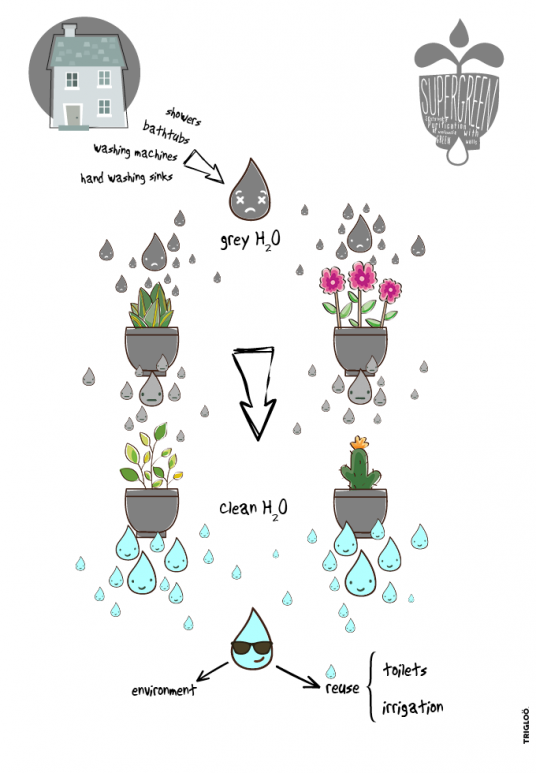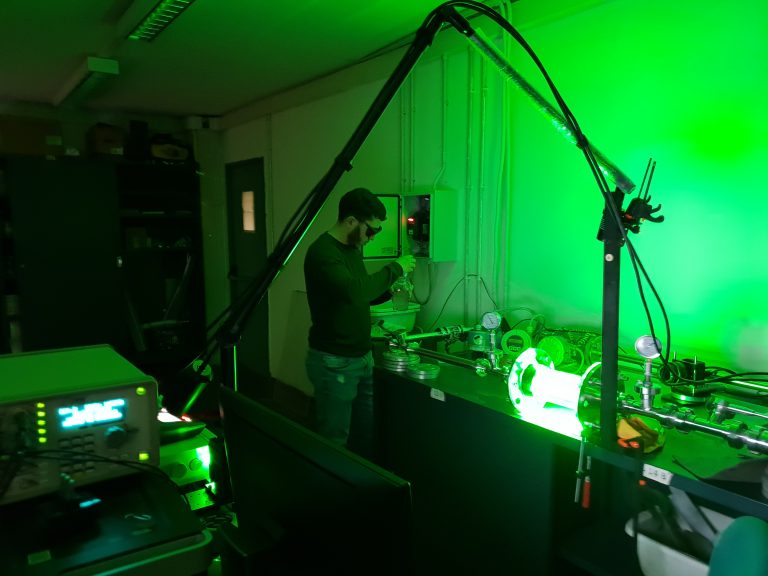OUR CURRENT PROJECTS
MD-SOLAR ENERGY
Membrane distillation (MD) is a thermally driven treatment process in which separation is enabled due to phase change. A hydrophobic microporous membrane acts as a barrier for the liquid phase, allowing water vapour to pass through the membrane pores, while retaining all species that do not volatilize, including salts. The driving force of the process is given by a temperature difference. The feed stream is usually in the range 50-70 ºC, while the permeate stream remains at ambient temperature. Solar thermal power may be effectively used to provide heat to increase the temperature of the feed streams, thus acting as the driving force for the process.
A custom-built MD lab setup (with an active membrane area of 50 × 10 cm) will be coupled with solar panels and with the two axis parabolic solar concentrator installed at DENERG. This concentrator has 10 m2 of collecting surface and maximum 8 kW of solar thermal power.
Aims:
- Demonstrate the possibility to effectively couple the systems
- Demonstrate the possibility to provide driving force in different periods throughout the year, also with energy storage
- Treat high salinity synthetic streams, mimicking seawater and produced water (oil & gas wastewater)
- Provide the basis (data, analysis, and evaluation of the process) for upscaling: a larger scale setup will be purchased and run to treat a to-be-chosen stream in an in-field application.
4

GREEN WALLS
Prof. Boano, in collaboration with Prof. Silvia Fiore, is implementing the project SUPERGREEN – SUstainable Purification of wastewatER with GREEN walls, funded by Compagnia di San Paolo.
The aim of this project is to use green walls, which are vegetated vertical elements that exploit unused building surfaces, for diluted graywater treatment. Additional benefits would be greening, improved aesthetics, and shading. SUPERGREEN will analyze different mixtures of conventional and innovative materials as growing media, to identify the most efficient green wall configuration.
Read more by clicking here.
SOLAR ATMOSPHERIC WATER GENERATOR

The SolAWG (Solar Atmospheric Water Generator) is a research project that combines adsorption material with solar energy to produce water from air for human use. Its functioning is based on a patent pending method. It is able to produce considerable amount of water in the presence of solar energy, also in arid climate conditions. solar collectors transforms sun radiation in thermal energy, that drives the thermodynamic cycle.
This project is supervised and developed by Marco Simonetti and Prof. Giovanni Vincenzo Fracastoro, partly supported by the CWC.
WATER-ENERGY NEXUS
This project investigates:
(i) the energy (kWh) and cost ($) required to transform grey water into blue water through treatment technology. These results are function of the grey water source that is being treated and of the technology used for treatment. It is also related to the extent of treatment needed for specific uses of blue water.
(ii) the blue water lost and/or consumed for the production of energy. This result is function of the technology used for energy production.
and it attempts to ultimately answer the question: “In case of water scarcity, where should water be directed: energy or food?”
HYDRODYNAMIC CAVITATION

In the project, Bubbles4Life, funded by Compagnia di San Paolo, Prof. Costantino Manes intends to develop a promising technique called Hydrodynamic Cavitation (HC). This technique relies on the principle of forcing water to flow in constricted regions and hence to make it boiling as a consequence of the low pressure levels it experiences. When pressure is restored, water bubbles implode violently generating conditions that are lethal for any microorganisms. The current understanding of the physical processes governing water-treatment through HC is very poor. The general aim of Bubbles4life is to bridge this knowledge gap and design reliable and low-cost HC reactors. HC does not require chemicals and/or high tech components, which makes it a perfect candidate for applications in developing countries.
Please read more by clicking here.

ENVIRONMENTAL SENSORS
Cost-effective, real-time, fast, and sensitive measurements allow early warning and quick response to contaminations and emergencies.
To detect emerging pollutants in water, we propose to develop innovative sensing platforms based on:
(i) economic and reliable portable detectors exploiting signature Raman signals of various substances, including PAH, nitrates, and other micropollutants
(ii) micro and/or nanofluidic resonators: such devices will combine nanofluidics with nanomechanics, to couple the extremely high mass sensitivity of nanomechanical resonators with electrokinetic effects for moving and confining particles, that are typical of micro/nanoscale fluids
reduction of fouling
 Objective of this research is the systematic investigation and optimization of pulsating flows as hydrodynamic means of enhancing instantaneous shear stress while maintaining low energetic costs. The research involves: numerical simulations to identify a range of promising pulsating flow configurations; validation of the numerical results by experiments where fouling rates and flow properties are monitored in a channel-flow rig constructed ad hoc, by means of state of the art laser-diagnostic techniques; application of the most promising methodologies and configurations in a laboratory scale cross-flow filtration system, to simulate the behavior of the membrane module in real application.
Objective of this research is the systematic investigation and optimization of pulsating flows as hydrodynamic means of enhancing instantaneous shear stress while maintaining low energetic costs. The research involves: numerical simulations to identify a range of promising pulsating flow configurations; validation of the numerical results by experiments where fouling rates and flow properties are monitored in a channel-flow rig constructed ad hoc, by means of state of the art laser-diagnostic techniques; application of the most promising methodologies and configurations in a laboratory scale cross-flow filtration system, to simulate the behavior of the membrane module in real application.
